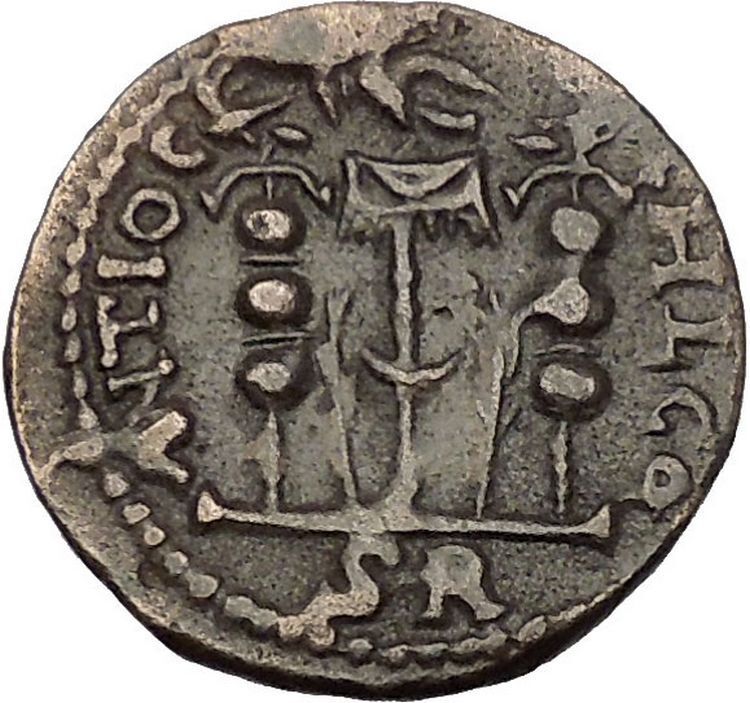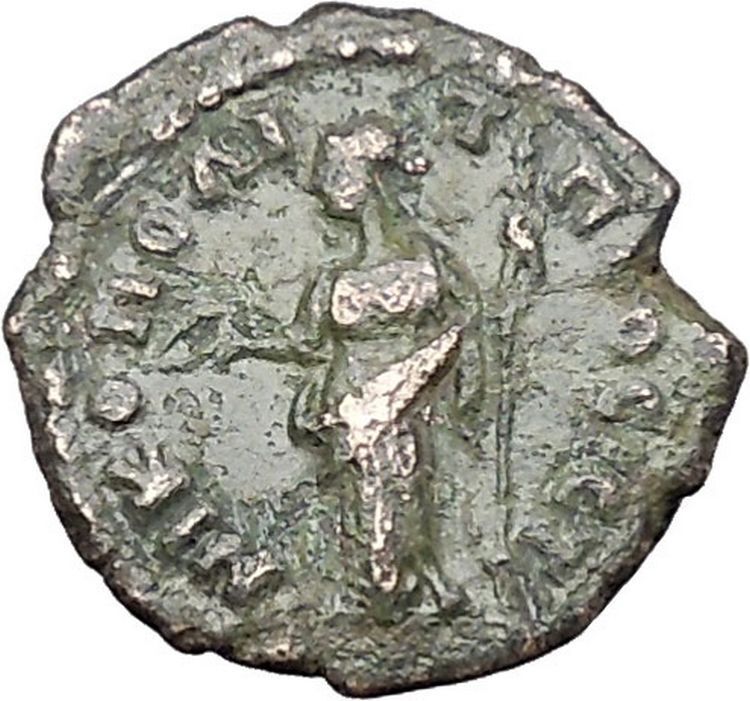|
Saloninus – Roman Caesar: 258-259 A.D. – Roman Emperor: 260
A.D. –
Bronze 22mm (4.90 grams) Pergamon in Mysia 258-260 A.D.
Π . Κ . CA . ΟVΑΛЄΡΙΑΝΟC ΚΑ, Bare-headed, draped
and cuirassed bust right.
ΠЄΡΓΑΜΝΩΝ ΝΕΩΚΟ, Dionysus standing left, holding bunch of grapes and thyrsos,
panther at feet to left.
* Numismatic Note: Possibly
Unpublished Type!!!
You are bidding on the exact item pictured,
provided with a Certificate of Authenticity and Lifetime Guarantee of
Authenticity.
Dionysus Bacchus was the
god
of the grape harvest,
winemaking
and
wine, of ritual madness and
ecstasy
in
Greek mythology
. His name in
Linear B
tablets shows he was worshipped from
c. 1500-1100 BC by
Mycenean Greeks
: other traces of Dionysian-type
cult have been found in ancient
Minoan Crete
. His origins are uncertain, and
his cults took many forms; some are described by ancient sources as Thracian,
others as Greek. In some cults, he arrives from the east, as an Asiatic
foreigner; in others, from
Ethiopia
in the South.

He
is a god of epiphany
, “the god that comes,” and his
“foreignness” as an arriving outsider-god may be inherent and essential to his
cults. He is a major, popular figure of
Greek mythology
and
religion
, and is included in some lists of the
twelve Olympians
. Dionysus was the last god to
be accepted into Mt. Olympus. He was the youngest and the only one to have a
mortal mother His festivals were the driving force behind the development of
Greek theatre
. He is an example of a
dying god
.The earliest cult images of Dionysus
show a mature male, bearded and robed. He holds a
fennel
staff, tipped with a pine-cone and known
as a thyrsus
. Later images show him as a
beardless, sensuous, naked or half-naked androgynous youth: the literature
describes him as womanly or “man-womanish.”In its fully developed form, his
central cult imagery shows his triumphant, disorderly arrival or return, as if
from some place beyond the borders of the known and civilized. His procession
(thiasus)
is made up of wild female followers (maenads)
and bearded
satyrs
with
erect penises
. Some are armed with the
thyrsus, some dance or play music. The god himself is drawn in a chariot,
usually by exotic beasts such as lions or tigers, and is sometimes attended by a
bearded, drunken Silenus
. This procession is presumed to be the
cult model for the human followers of his
Dionysian Mysteries
. In his
Thracian
mysteries, he wears the bassaris
or
fox-skin, symbolizing a new life. Dionysus is represented by city
religions as the protector of those who do not belong to conventional society
and thus symbolizes everything which is chaotic, dangerous and unexpected,
everything which escapes human reason and which can only be attributed to the
unforeseeable action of the gods.
He was also known as Bacchus, the name adopted by the
Romans
and the frenzy he induces, bakkheia.
His thyrsus is sometimes wound with ivy and dripping with honey. It is a
beneficent wand but also a weapon, and can be used to destroy those who oppose
his cult and the freedoms he represents. He is also the Liberator (Eleutherios),
whose wine, music and ecstatic dance frees his followers from self-conscious
fear and care, and subverts the oppressive restraints of the powerful. Those who
partake of his mysteries are possessed and empowered by the god himself. His
cult is also a “cult of the souls”; his maenads feed the dead through
blood-offerings, and he acts as a divine communicant between the living and the
dead.
In Greek mythology, he is presented as a son of
Zeus and the mortal
Semele
, thus semi-divine or
heroic: and as son of Zeus and
Persephone
or
Demeter
, thus both fully divine, part-chthonic
and possibly identical with
Iacchus
of the
Eleusinian Mysteries
. Some scholars believe
that Dionysus is a
syncretism
of a local Greek nature deity and a
more powerful god from
Thrace
or
Phrygia
such as
Sabazios
or
Zalmoxis
.
Pergamon, Pergamum or Pérgamo (in
Greek
, Πέργαμος) was an ancient
Greek
city in modern-day
Turkey
, in
Mysia
, today
located 16 miles (26 km) from the
Aegean Sea
on a promontory
on the north side of the river
Caicus
(modern day
Bakırçay
),
that became the capital of the
Kingdom of Pergamon
during the
Hellenistic period
, under the
Attalid dynasty
, 281-133 BC. Today, the main sites of ancient Pergamon are
to the north and west of the modern city of
Bergama
.
Publius Licinius Cornelius Saloninus (242 – 260) was
Roman
Emperor
in 260.
Saloninus was born around the year 242. His father was the later emperor
Gallienus
,
his mother
Cornelia Salonina
a
Greek
from Bithynia. In 258 Saloninus was appointed
Caesar
by his father (just like his older brother
Valerian
II
, who had died around 258) and sent to
Gaul, to make sure
his father’s authority was respected there. (The title Caesar in Imperial
nomenclature indicated that the holder was the Crown Prince and First-in-line-of
Succession after Augustus, the title reserved to the ruling Emperor).
Like Valerian II who was made the ward of
Ingenuus
,governor
of the Illyrian provinces, Saloninus was put under the protection of
Silvanus (praetorian prefect)
(otherwise named as Albanus)
As Caesar in Gaul Saloninus had his main seat in
Cologne
.
Bray conjectures
that Saloninus’s appointment as Caesar, like that of his elder brother,
Valerian II, in Illyria, was made at the instigation of
Valerian
who was, at once, the senior Emperor (Augustus) and grandfather of the two young
Caesars and, as head of the Licinius clan, exercised also the potestas
patriae
over all members of the Imperial family, including his son Gallienus, his
co-Emperor (and co-Augustus). Bray suggests that Valerian’s motive in making
these appointments was the establishment of an Imperial dynasty, thus making the
succession more secure. We do not know how Valerian envisaged his grandson
interacting with the existing governors and military commanders of the Gallic
provinces. There is no reason to suppose that he ever thought the thing through
as systematically as
Diocletian
when he established the
Tetrarchy
some thirty years later. However, Silvanus must have been a seasoned
soldier/administrator and he does seem to have harboured the notion that, as
guardian of Valerian, he should exercise real authority in Gaul. This was
demonstrated by the circumstances in which he fell out with the
usurper
Postumus
.
In 260 (probably in July) Silvanus (no doubt in Saloninus’s name) ordered
Postumus to hand over some booty that Postumus’s troops had seized from a German
warband which had been on its way home from a successful raid into Gaul.
However, Postumus’s men took violent exception to this attempt to enforce the
rights of the representative of a distant Emperor who was manifestly failing in
his duty to protect the Gallic provinces. Asserting what was probably the
prevailing Custom of the Frontier they turned on Saloninus and Silvanus who had
to then flee to Cologne with some loyal troops. It was probably at this time
that Postumus was acclaimed Emperor by his army. Riding the tiger of military
discontent which he could barely control, Postumus then besieged Saloninus and
Silvanus in Cologne.
Gallienus, who was fully engaged elsewhere – probably campaigning on the
middle Danube – could do nothing to save his son. (By this time Saloninus’s
grandfather, the senior Emperor, Valerian was probably already a captive of the
Persian King Shapur
).
Saloninus’s troops, in their desperation, finally proclaimed him Emperor,
perhaps hoping that this would induce Postumus’s army to desert him and join
them in a bid for Empire – i.e. against Valerian and Gallienus. If this was
indeed their hope, they were to be disappointed in the event for Postumus’s army
pressed on with the siege and, about one month later, the citizens of Cologne
handed Valerian and his guardian over to their enemy. Postumus was then unable
to prevent his army from murdering them. (Despite his public protestations of
regret, it seems unlikely, in fact, that Postumus made a serious effort to this
resist this course of events).
Whether or not Gallienus ever concurred with Valerian’s dynastic experiment
is not known. Certainly the murder of Saloninus so soon after the suspicious
death of Valerian II (q.v.)seems to have cured Gallienus of any ambition
in this regard. (We may assume that Valerian’s mother, Salonina, would have been
most unhappy: the death of her elder son, Valerian II, in Illyria under the
tutelage of Ingenuus
must have seemed to her to have confirmed her worst fears of this
sort of arrangement). It had certainly proved to be folly to set up
inexperienced boys as hostages to fortune and hope that their relationship to
the Imperial family would quell provincial resentment at what was perceived as
the inability of the central government to secure the frontiers from barbarian
attack. Throughout the period of his sole reign Gallienus made no effort to
elevate his third son,
Egnatius Marinianus
, to the purple or associate him in any way with his
government of the Empire – although he did allow him to be elected to the
largely ceremonial office of Consul in 268.
|








